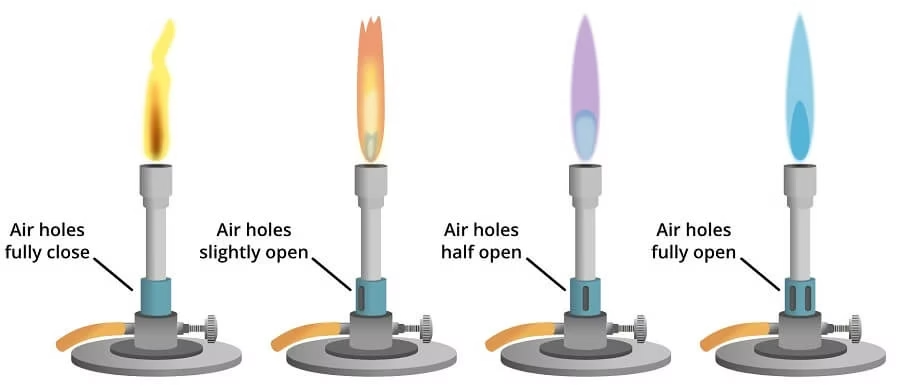Introduction
The Bunsen burner is one of the most common and essential pieces of laboratory equipment. It produces a controlled, smokeless, non-luminous flame used for heating, sterilization, and combustion in various scientific experiments.
Invented in 1857 by German scientist Robert Bunsen and his assistant Peter Desaga, this device revolutionized laboratory heating methods by providing a safer and more controllable flame than candles or oil lamps. Today, it is a staple in biology, chemistry, physics, and microbiology labs.
Principle of Bunsen Burner
The Bunsen burner works on the principle of air-gas mixing before ignition to produce a clean, hot flame.
- Gas Supply – The burner is connected to a laboratory gas source, typically methane (natural gas) or liquefied petroleum gas (LPG).
- Air Mixing – Air is drawn in through holes at the base using the Venturi effect, mixing with the gas before combustion.
- Combustion Control – An adjustable collar at the base controls the amount of air entering the burner.
- Flame Types – Different air settings produce different flames:
- Yellow (Safety) Flame – Air holes closed, cooler temperature.
- Blue Flame – Air holes partially open, hotter flame.
- Roaring Blue Flame – Air holes fully open, maximum heat.
Parts of Bunsen Burner and Their Functions

- Base or Stand
- Provides stability to prevent tipping over.
- Often made of heavy metal.
- Barrel or Chimney
- Vertical tube where gas mixes with air before burning.
- Contains air vents near the bottom.
- Collar
- Rotating part at the base of the barrel.
- Adjusts the amount of air entering through the air holes.
- Air Holes
- Openings that allow air to mix with gas.
- Air supply determines flame type and temperature.
- Gas Valve
- Controls the flow of gas into the burner.
- Gas Inlet Tube
- Connects the burner to the gas source via a rubber hose.
Fuel Sources for Bunsen Burners
- Natural Gas (Methane) – Common in laboratories.
- LPG (Propane, Butane, or Mix) – Used when natural gas is unavailable.
* A burner designed for one fuel should not be used with another.
Types of Bunsen Burners
1. Meker-Fisher Burner
- Wider barrel for better air-gas mixing.
- Flame divided into smaller sections using a grid at the top.
2. Teclu Burner
- Longer barrel, better mixing, and higher temperature flames.
- Adjustable gas screw for precision control.
3. Tirril Burner
- Disc valve at the base for gas regulation.
Types of Flames in a Bunsen Burner
| Flame Type | Air Hole Setting | Temperature | Characteristics |
| Yellow Flame | Closed | ~300°C | Luminous, cooler, safety flame |
| Blue Flame | Half open | ~500°C | Non-luminous, hotter |
| Roaring Flame | Fully open | ~700°C | Very hot, noisy, for intense heating |

Applications of Bunsen Burner
In Microbiology
- Sterilizing inoculating loops and needles.
- Flaming the mouths of culture tubes to maintain sterility.
In Chemistry
- Heating solutions and chemical reactions.
- Evaporating solvents.
- Testing flammability of compounds.
In Physics
- Heating materials for expansion studies.
- Demonstrating convection currents.
Other Uses
- Melting small quantities of substances.
- Determining boiling and melting points.
Advantages of Bunsen Burner
- Simple to operate.
- Provides adjustable flame temperatures.
- Inexpensive to run.
- Portable in labs with gas supply.
Limitations of Bunsen Burner
- Open flame poses fire hazard.
- Requires constant supervision.
- Limited temperature control compared to electric heaters.
Precautions When Using a Bunsen Burner
- Work in a clutter-free area.
- Tie back long hair and avoid loose clothing.
- Inspect rubber tubing for leaks.
- Use a spark lighter instead of matches.
- Never leave the burner unattended.
- Turn off gas immediately after use.
- Allow burner to cool before handling.
Examples of Modern Bunsen Burners
- FIREBOY Safety Bunsen Burner – Automatic ignition, flame monitoring.
- Marienfeld Superior Bunsen – Nickel-plated air regulation.
- Techno Gaz 4056/B – Safety thermocouple shut-off.
- Medline BEC2 Series – Electric alternative with focused heat stream.
Frequently Asked Questions (FAQ)
Q1. Who invented the Bunsen burner?
Robert Bunsen and Peter Desaga in 1857.
Q2. Why is the yellow flame called a safety flame?
It is cooler, more visible, and used when the burner is not actively heating.
Q3. Which flame is best for heating?
The roaring blue flame—hottest and cleanest.
Q4. Can Bunsen burners be used with any gas?
No, each is designed for a specific fuel type.
Q5. What is the Venturi effect in Bunsen burners?
It is the drawing in of air into the gas stream through air holes to mix before combustion.
References
- https://dlu.com.ua/FIREBOY-Safety-Bunsen-Burner
- https://edulab.com/the-bunsen-burner-what-is-it-and-how-to-use-it-safely/
- https://psiberg.com/bunsen-burner/
- https://sites.google.com/site/glenscienceeportfolio/reflections/bunsen-burner-and-types-of-flames
- https://www.directindustry.com/prod/medline-scientific-ltd/product-107585-2357621.html
- https://www.google.com/amp/s/universe84a.com/bunsen-burner-introduction/%3famp=1
- https://www.hbarsci.com/blogs/articles/10099273-understanding-products-bunsen-burners
- https://www.jove.com/v/5035/introduction-to-the-bunsen-burner
- https://www.marienfeld-superior.com/burners-acc-to-bunsen.html
- https://www.medicalexpo.com/prod/tecno-gaz/product-70281-633645.html
Other related topics you might be interested in:
Autoclave – Principle, Parts, Procedure, Types, Uses, Advantages, Limitations
Bioreactor – Principle, Design, Parts, Types, Applications, and Limitations
Centrifuge – Principle, Parts, Types, Operation, Applications and Advantages
Colony Counter – Definition, Principle, Types, Parts, Working, Applications, Advantages & Examples
Homogenizer – Principle, Parts, Types, Working, Procedure, Applications, Advantages & Limitations
Instruments Used in Microbiology Laboratory – Principles, Uses, and Applications
Laboratory Incubator – Principle, Types, Components, Working, Applications, Advantages & Limitations
Micropipette – Definition, Types, Parts, Working, Applications, Errors, Calibration & Limitations
pH Meter – Principle, Parts, Working, Procedure, Types, Applications, Advantages & Precautions
Pipettes – Principle, Types, Uses, Parts, Operation, Advantages & Precautions
Ultracentrifuge – Principle, Types, Parts, Working Procedure, Applications, Advantages & Precautions
Vortex Mixer – Definition, Principle, Parts, Types, Working, Applications, Advantages & Precautions
